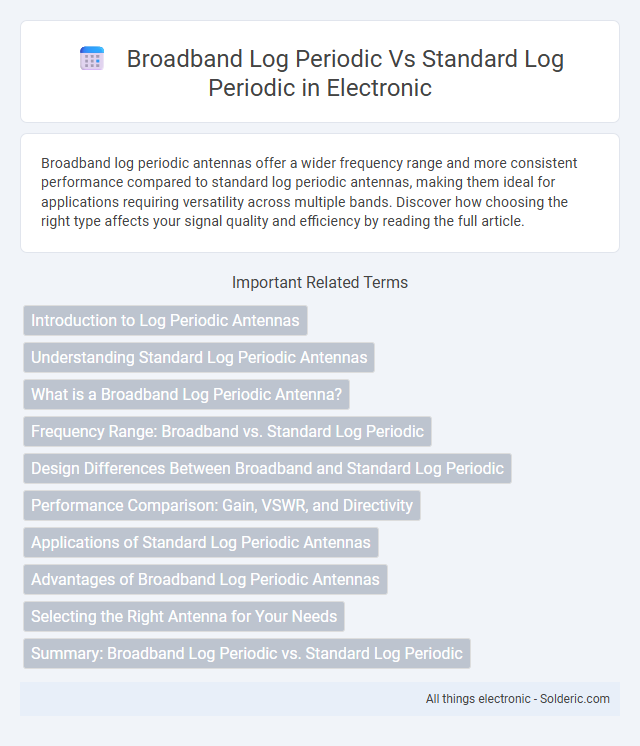Broadband log periodic antennas offer a wider frequency range and more consistent performance compared to standard log periodic antennas, making them ideal for applications requiring versatility across multiple bands. Discover how choosing the right type affects your signal quality and efficiency by reading the full article.
Comparison Table
| Feature | Broadband Log Periodic Antenna | Standard Log Periodic Antenna |
|---|---|---|
| Frequency Range | Very wide, covers multiple GHz ranges | Moderate, focused on specific frequency band |
| Gain | Lower to moderate gain, consistent over wide band | Higher gain within narrower band |
| Impedance | Stable across broad frequency spectrum | Good impedance match in targeted frequency range |
| Design Complexity | More complex with precise scaling of elements | Simpler design with uniform element spacing |
| Application | Wideband communications, spectrum monitoring, EMC testing | Specific frequency applications, point-to-point links |
| Physical Size | Larger due to wider frequency coverage | Smaller, optimized for narrower band |
| Beamwidth | Moderate, consistent across frequency range | Narrower in operating band |
| Cost | Higher, due to design and materials | Lower, straightforward manufacture |
Introduction to Log Periodic Antennas
Log periodic antennas feature a distinctive design with elements arranged in a logarithmic progression to achieve wideband frequency coverage and consistent impedance. Broadband log periodic antennas extend this concept by optimizing element scaling and spacing, enabling superior performance across an even wider frequency range with improved gain stability. Standard log periodic antennas typically offer reliable directional characteristics and moderate bandwidth but may exhibit reduced efficiency at extreme frequencies compared to broadband variants.
Understanding Standard Log Periodic Antennas
Standard log periodic antennas feature a well-defined frequency range with consistent directional gain, making them ideal for reliable broadband signal reception. Their design includes elements arranged in a logarithmic scale, ensuring stable impedance and predictable performance across specified frequencies. Understanding these antennas helps you select the appropriate option for applications requiring steady broadband coverage and efficient signal transmission.
What is a Broadband Log Periodic Antenna?
A broadband log periodic antenna is designed to operate efficiently across a wide range of frequencies, providing consistent gain and radiation patterns from VHF to UHF bands. Unlike standard log periodic antennas that are optimized for a narrower frequency range, broadband versions feature carefully spaced elements that enhance bandwidth and impedance matching for versatile applications. Your choice of a broadband log periodic antenna ensures reliable performance in scenarios demanding multi-band coverage, such as scouting, broadcasting, and communication monitoring.
Frequency Range: Broadband vs. Standard Log Periodic
Broadband log periodic antennas provide an extended frequency range, typically covering from as low as 30 MHz up to several GHz, enabling versatile applications across multiple communication bands. Standard log periodic antennas usually have a narrower frequency range, optimized for specific segments with improved gain and directivity within that limited spectrum. Your selection between broadband and standard log periodic antennas should consider the required frequency flexibility and application-specific performance needs.
Design Differences Between Broadband and Standard Log Periodic
Broadband log periodic antennas feature wider frequency ranges due to optimized element spacing and length variations, providing consistent impedance and gain across the spectrum. Standard log periodic designs emphasize narrower bandwidth with fixed element scaling, resulting in more focused directional patterns and higher efficiency within specific frequency bands. Your choice depends on whether you prioritize broad frequency coverage or targeted signal performance.
Performance Comparison: Gain, VSWR, and Directivity
Broadband log periodic antennas offer a wider frequency range with relatively consistent gain, typically ranging between 6 to 9 dBi, compared to standard log periodic antennas, which may provide higher peak gain but over narrower bands. VSWR in broadband designs tends to remain below 2:1 across the extended frequency spectrum, ensuring efficient signal transmission, whereas standard log periodic antennas might exhibit better VSWR at their optimized frequencies but degrade outside those ranges. Directivity in broadband models maintains moderate stability, facilitating broad coverage for your applications, while standard log periodic antennas often achieve higher directivity at specific frequencies, enhancing performance in targeted frequency bands.
Applications of Standard Log Periodic Antennas
Standard log periodic antennas are widely used in applications requiring consistent performance across a broad frequency range, including TV reception, HF and VHF communications, and electromagnetic compatibility testing. Their predictable impedance and gain characteristics make them ideal for measurement and calibration in antenna test ranges and field strength assessments. You can rely on standard log periodic antennas for reliable directional communication and wideband signal acquisition in telecommunications and broadcasting industries.
Advantages of Broadband Log Periodic Antennas
Broadband log periodic antennas provide a wider frequency range, enabling your communication systems to operate efficiently across multiple bands without the need for multiple antennas. Their stable gain and consistent radiation pattern across the entire frequency spectrum reduce signal distortion and improve overall transmission quality. This makes broadband log periodic antennas ideal for applications requiring versatility and reliable performance in varying signal environments.
Selecting the Right Antenna for Your Needs
Selecting the right antenna, whether broadband log periodic or standard log periodic, depends on your frequency range and gain requirements. Broadband log periodic antennas provide a wider frequency coverage and smoother impedance matching, making them ideal for applications needing versatility across multiple bands. Standard log periodic antennas offer higher gain and focused performance within a narrower frequency range, suited for targeted communication or signal reception tasks.
Summary: Broadband Log Periodic vs. Standard Log Periodic
Broadband log periodic antennas offer wider frequency coverage and improved impedance matching compared to standard log periodic antennas, making them ideal for applications requiring consistent performance across broad frequency ranges. Standard log periodic antennas typically provide narrower bandwidth with more focused directivity, suitable for targeted frequency operations. Both types differ in element design and spacing, impacting gain stability, radiation pattern, and overall efficiency.
broadband log periodic vs standard log periodic Infographic

 solderic.com
solderic.com